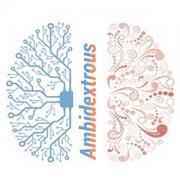BT & DTS EXECUTIVE UPDATE VOL. 22, NO. 4

Today’s competitive and highly volatile environment calls for a new kind of flexibility and adaptability. At the same time, standardization, efficiency, and scale must continue to dominate the CxO agenda in order to deliver against margin and profit expectations. Top executives face the challenge of delivering against both requirements, yet conventional organizational wisdom provides little guidance on how to resolve this tradeoff in day-to-day operations.
The concept of the ambidextrous organization offers new, tangible, and balanced answers to this most pressing management dilemma (see Figure 1).
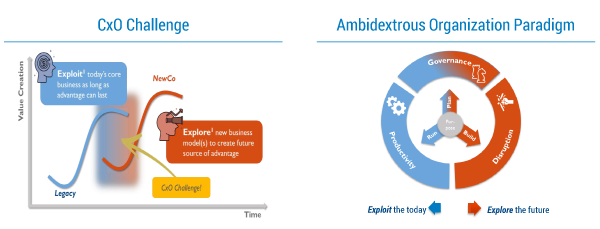
Based on our experience and in-depth discussions with organizational development leaders, we created the Ambidextrous Organization Development Canvas, which helps management answer three simple questions:
-
 Where does my organization currently stand in terms of its set of organizational capabilities?
Where does my organization currently stand in terms of its set of organizational capabilities? -
What organizational capabilities does my business need, considering both the strategic context and business requirements?
-
What kind of organizational development path does my business need to build a sound balance between scale/productivity and speed/creativity?
The most obvious and tangible benefit of the Ambidextrous Organization Development Canvas is that it enables management teams to discuss organization development issues in a common language and make decisions on development aims and organization transformation priorities (see Figure 2).
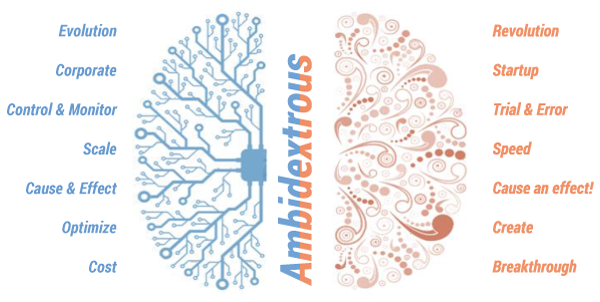
Ambidextrous as a New Organizational Archetype
Companies can be considered “ambidextrous” when they continuously solve the tradeoff between being fast/creative and scale-driven/productive. As such, they establish an equilibrium characterized by a strong emphasis on both dimensions. The vast majority of companies focus on one or the other dimension; those that manage to excel in both areas are rare.
As shown in Figure 3, businesses with an emphasis on speed/creativity possess strong capabilities that enable anticipation, innovation, and adaptation. These translate into corporate attributes such as insight and foresight, inspiration and passion, and trial and error.
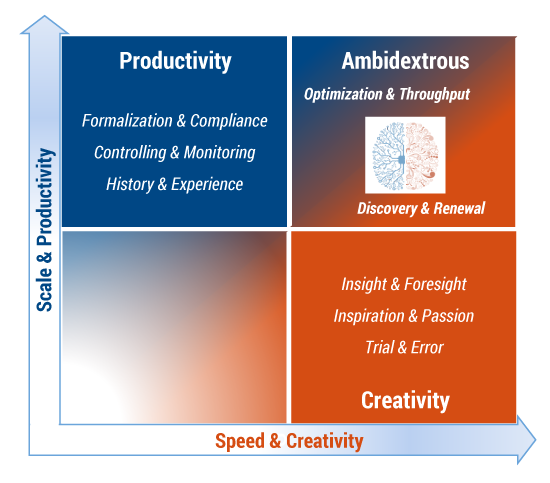
In contrast, companies that excel in the scale/productivity dimension demonstrate strong capabilities when it comes to planning, as well as optimization and control, resulting in attributes such as formalization/compliance, controlling/monitoring, and history/experience.
Amazon is a prime example of the new breed of ambidextrous organizations. Always searching for the most innovative business ideas, the company strives to deliver on customers’ needs before people realize that they require them. This approach is driven by a well-established culture of invention, curiosity, and bias for action. Complementing its creative side, Amazon has also proven itself to be a champion of productivity. The company’s logistics — as well as its internal processes for scaling new business models — are tailored for pure efficiency and standardization. If a new approach proves to be successful, it is rolled out rapidly, formally established, monitored, and aligned to deliver full productivity. By successfully balancing these two dimensions, Amazon has built a sustainable competitive advantage that has become accepted best practice across multiple industries. Clearly, not every company can or wants to follow Amazon’s development path; nor should they necessarily do so. The art is more in finding actionable organizational answers that specifically address a company’s business context, taking into account its history, development path, future challenges, and strategic targets.
Creating Organizational Advantage in the Age of Disruption
The existing body of knowledge on ambidextrous principles1 provides a compelling academic framework but falls short of making it actionable within a real-life corporate context. To overcome this, we have developed the Ambidextrous Organization Development Canvas, which drills down from six design dimensions into 72 specific capabilities.
Its starting point consists of six major design dimensions, which form mutually enhancing pairs. These are:
-
Steering and transformation — the engine that drives performance and change
-
People and culture — the glue that holds an organization together
-
Structure and processes — the hardware of an organization
Each dimension breaks down into various design elements, which, in turn, are comprised of a set of capabilities. These are the smallest elements of organizational systems. They constitute how the organization thinks, feels, and acts. This approach has proven to be a highly valuable tool for analyzing organizational capabilities; discussing these learnings with leaders and staff; defining the target for organizational development; and deriving clear, actionable steps to improve the organization on the level of individual capabilities.
Applying our model to a broad range of organizations across multiple contexts has enabled us to decode and understand the underlying DNA of ambidextrous organizations. Figure 4 depicts the high-level model of an ambidextrous organization. It highlights key capabilities developed within the organization for each of the six design dimensions.
In Figure 4, you will notice two distinct organizational systems: scale/productivity (in blue) and speed/creativity (in red). Each system is defined by well-established, reinforcing capabilities in both the people/culture and structure/process dimensions. The blue scale/productivity system is characterized by factors such as transactional and formalized leadership and professional skills as core competences, internal collaboration guided by hierarchy and cross-functional teams, and standardized process management. In contrast, the red speed/creativity system demonstrates empowered and transformational leadership via self-management and self-development skills as central competences, with an organizational setup that is market- and customer-centric.
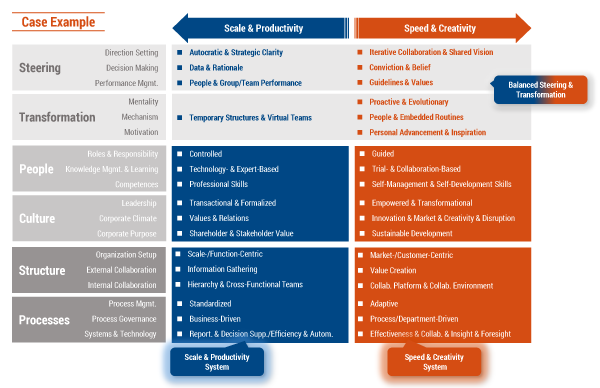
(Source: Arthur D. Little.)
Within the organization, certain units and processes are predominantly focused on the blue system, while others are mainly tailored to the red. It is important to understand that both systems coexist under one organizational roof and reinforce each other. The key to success of this ambidextrous model is a balanced steering/transformation layer, where the organization’s leadership can steer and guide both types of systems. Certain units are directed with performance management centered around people and group/team performance, while others are driven in a loose manner with guidelines and values.
So how do you move toward becoming ambidextrous? Figure 5 shows in detail the as-is structure for a manufacturing company, derived from a thorough organizational assessment, as well as the desired to-be target picture and how to achieve it.
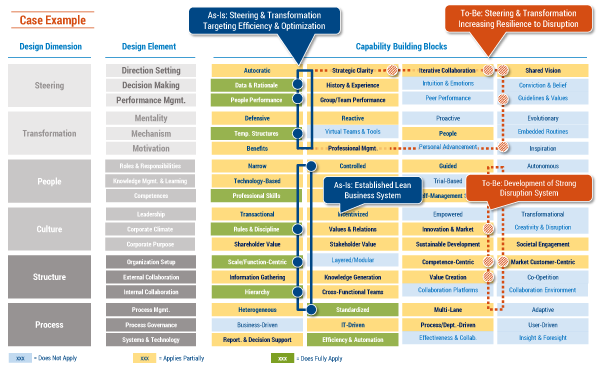
(Source: Arthur D. Little.)
The two models can be described as follows:
-
As-is (existing capabilities). This is a well-established scale/productivity model, made up of distinct capabilities within the process/structure and people/culture dimensions. These all support a business goal focused on efficiency and optimization. This is mirrored by a steering/transformation layer that supports decision making based on data and rational thinking, manages operations based on people performance, and executes transformation via temporary structures.
-
 To-be (additional capabilities to strengthen and develop). The aim is to increase the resilience of the business by complementing the existing skill set with speed/creativity capabilities, enabling the business to respond adequately to external disruptions. This means taking advantage of emerging opportunities based on capabilities that support innovation and flexibility along the speed/creativity axis. These new capabilities need to be mirrored in the organization’s steering/transformation approach. For this specific company, this means developing a shared vision, managing performance based on guidelines and values, and motivating through inspiration.
To-be (additional capabilities to strengthen and develop). The aim is to increase the resilience of the business by complementing the existing skill set with speed/creativity capabilities, enabling the business to respond adequately to external disruptions. This means taking advantage of emerging opportunities based on capabilities that support innovation and flexibility along the speed/creativity axis. These new capabilities need to be mirrored in the organization’s steering/transformation approach. For this specific company, this means developing a shared vision, managing performance based on guidelines and values, and motivating through inspiration.
These models are not either/or but follow a modular logic. The as-is model must be carefully supplemented with additional capabilities in order to achieve the desired equilibrium while remaining consistent with strategic targets. For every company, top management must decide which balance is best suited for its business objectives and current skill sets. For example, a nuclear power plant is not supposed to foster a creative and disruptive culture; it should be based on rules and discipline. On the other hand, startups in the digital space are more likely to follow a shared vision when it comes to direction setting, rather than taking autocratic approaches. (For a detailed example of a company’s move to become ambidextrous, see the Appendix.)
Wilhelm Lerner's on-demand webinar on this topic shows how your organization can achieve this critical balance... Watch it at your convenience.
For some companies, becoming more creative might be the right path for success, while for others, it might be moving up the productivity axis. However, the key aim is to combine these different systems under the same overarching steering/transformation umbrella. Mastering these opposing organizational systems is what makes ambidextrous organizations outstanding.
New Answers to the Organizational Development Challenge
We believe existing organizational development approaches are not far-reaching or holistic enough when it comes to the scope of the issues they address. Most methods either focus on strengthening the scale/productivity dimension (often within the context of Lean models) or push the speed/creativity dimension (commonly referred to as the Agile model). However, choosing either the Lean or the Agile path does not provide the right mindset and tools to address the complexity and competitive challenges of most large organizations. Moreover, those frameworks that are ambidextrous are not operationally focused enough to enable day-to-day management and lack a link between strategy definition and organizational development. From our experience, these missing qualities are essential to making well-informed business decisions.
Building a tailored, fit-for-purpose organizational equilibrium therefore requires new thinking on organizational development. First, it has to go beyond an either/or approach and ask for the best combination. There is no silver bullet for organizational development, as every company’s own response to VUCA (volatility, uncertainty, complexity, and ambiguity) challenges has to be very specific. Therefore, companies should not follow generic, high-level target models, which often overemphasize single aspects. Organizational development must be granular enough to identify specific areas that require change, while ensuring that these changes are consistent with strategic requirements and the overall organizational model. Despite the current dominance of the agility imperative for company development, these specific changes are equally likely to relate to scale/productivity characteristics.
Second, the journey to the desired model requires a modular and balanced approach. Organizational capabilities must build a system of self-reinforcing elements that can selectively be developed or swapped in or out. This means the one-dimensional development path is replaced by a need to develop multiple capabilities that create balanced systems that coexist in the organization, tailored to specific strategic and business requirements. This approach is the only one that allows a company to purposely change its balance toward one dimension or the other.
Third, organizational and strategy development need to be more closely linked. Often, the implications of the strategy process on the operating model and organization development are unclear and not thought through. Strategy and organizational development need to be linked in order to provide results that are precise enough to both identify specific areas for improvement and develop a set of relevant measures to achieve success.
Insight for the Executive
Organizational resilience is emerging as a key source of competitive advantage in the age of hyper-competition and disruption. Organizational development therefore needs to become a top priority for the CxO. A new breed of leaders understands that winning requires ambidextrous organizations to embrace both scale/productivity and speed/creativity.
The vast majority of organizations have not achieved this new balance yet — and most have not even begun their journeys. Yet all senior leaders, executives, and organization development staff we have talked to have expressed the need to address the organizational dilemmas they face. Consequently, most companies have untapped upside potential.
Finding your unique organizational equilibrium requires new thinking toward organizational development:
-
Understand that every organization is different, with specific needs requiring more complex answers than an either/or approach can deliver. There is no silver bullet for organizational development anymore.
-
Take a modular approach, using organizational capabilities to build a self-reinforcing system.
-
Guide organization development with a strong link to strategy.
Beyond these three principles, leaders must acknowledge that their decision-making cultures as well as leadership behavior critically determine their organizations’ ability to become ambidextrous. Only a balanced steering and transformation layer, reflected in the organization’s leadership, enables a combination of different systems under one organizational roof.
To move toward ambidexterity, evaluate your organization during your next strategy development cycle, using the concept of capability building blocks to find a path toward the desired individual organizational equilibrium. This approach is based on three steps:
-
Conduct an organizational assessment. Assess your organization against a set of capability building blocks, giving the business a unifying language to express the current state of the organization. Knowing where you are now creates the foundations for an organizational transformation roadmap.
-
Build an organizational target picture based on your strategic ambition. Determine the right target model to support the strategic cornerstones defined by top management. This provides a compass for the organizational development journey. The primary focus should be on how you change steering/
transformation dimensions, as this is the essential layer that will make the whole new organization work, combining multiple systems in one organization. -
Derive the necessary measures to build up the capabilities. The result of the third step is a transformation roadmap that should speak to your organization and its needs. This must address people’s mindsets, revamp organizational practices and routines, provide the necessary tools and methods for transformation, and, above all, outline and promote new leadership behaviors. If it does not, it is doomed to fail fast.
Applying an Ambidextrous Organization Development Canvas and assessment model results in a clear picture of where the organization is now, and where it needs to be. It also delivers the levers and the language to start this holistic organizational development endeavor. In an era when disruption is only increasing in many markets, it is time to embrace ambidextrous organizational models if your business is to balance speed/creativity and scale/productivity.
Appendix
Case Study: Journey Toward Becoming Ambidextrous
AGC Building and Industrial Glass Europe (AGC) wanted to add capabilities to continuously drive disruptive new business model innovations. The aim was to add and enhance the organization’s operational experience with emotional connections to customers who were new to the business. It codified this ambition in a set of target values and behavior characteristics, translating them into its corporate language and specific needs (see Figure A).
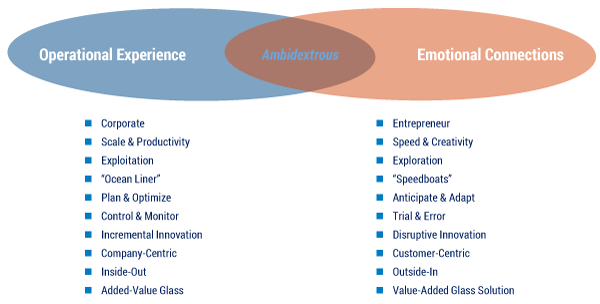
AGC launched two new disruptive glass value propositions: Clara (a window with an entirely glass frame) and Halio (smart-tinting glass). The lessons senior management learned can be distilled into six principles:
-
Ensure alignment with both vision and direction.
-
Align organization modeling with the direction.
-
Create room for disruptive innovation inside the organization.
-
Explore and exploit adjacent markets.
-
Deploy a dedicated governance model, comprising specific transformation-steering bodies and a fast decision-making process.
-
Invest in people and develop the right culture.
What We Learned
Adding Agile and creative capabilities to a productivity-focused business and organization model requires:
-
A holistic initiative that addresses all parts of the organization model
-
Senior leaders determined to enhance and adapt their personal and leadership team behavior and decision-making culture to enable the new normal
-
Dedicated “speedboats” established inside the organization to develop, drive, and showcase the new organizational pattern


